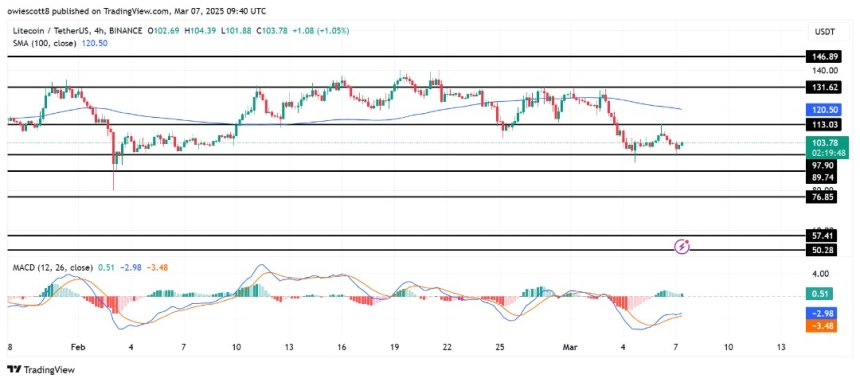Litecoin Price Upsurge Cools Off – What’s Next After The $97.8 Drop?

Litecoin’s bullish momentum has cooled off, with the price sliding back to $97.8 after struggling to sustain its recent uptrend. The pullback comes amid increasing selling pressure, raising concerns about whether this is a temporary correction or the start of a deeper decline. While LTC previously showed strength, the inability to maintain higher levels suggests that market sentiment is shifting, leaving traders questioning the coin’s next move.
As the price approaches key support levels, traders are closely monitoring market signals to determine the next move. Will buyers step in to defend LTC and spark a rebound, or will bearish pressure push the price even lower?
Litecoin Drop To $97.8: What Triggered The Pullback?
Litecoin’s retreat to $97.8 comes after failing to sustain its recent uptrend, as increasing selling pressure drove the price lower. After an initial push higher, LTC encountered strong resistance at the $113 key level, preventing further gains and triggering a pullback. This resistance rejection prompted profit-taking among traders, as many opted to secure gains rather than hold through potential volatility.
Moreover, the decline in buying momentum played a crucial role in the price drop. As bullish enthusiasm faded, buyers struggled to maintain control, allowing sellers to take over. The weakening demand led to increased downward pressure, accelerating Litecoin’s descent toward the $97.8 support level.

Broader market uncertainty also contributed to the downturn. A combination of external factors, including macroeconomic conditions and Bitcoin’s price action, likely influenced traders’ risk appetite, leading to a cautious approach toward altcoins like LTC.
Technical indicators also experienced a drop below average, prompting a correction as traders reassessed their positions. If Litecoin fails to hold above $97.8, further downside could be expected. However, a possible recovery may be on the horizon if buyers step in at this level.
Potential Scenarios: Rebound Or Further Decline?
The Litecoin price movement around the $97.8 level will be crucial in determining its next direction. Two possible scenarios could unfold—a strong rebound if buyers regain control or a deeper decline if selling pressure persists.
In a bullish scenario where LTC manages to hold above $97.8, buyers could step in, driving the price toward immediate resistance levels. A successful rebound might push Litecoin back above $113, with the next target being $131.6. After this, bullish momentum may grow, paving the way for a rally to $146.
However, in a bearish scenario where Litecoin fails to hold above $97.8, the price could face additional downside pressure. Breaking below this key support hints at a decline toward $89.7 and $76.8, and even lower support zones, making it critical for bulls to defend key levels.
Litecoin Price Upsurge Cools Off – What’s Next After The $97.8 Drop?

Litecoin’s bullish momentum has cooled off, with the price sliding back to $97.8 after struggling to sustain its recent uptrend. The pullback comes amid increasing selling pressure, raising concerns about whether this is a temporary correction or the start of a deeper decline. While LTC previously showed strength, the inability to maintain higher levels suggests that market sentiment is shifting, leaving traders questioning the coin’s next move.
As the price approaches key support levels, traders are closely monitoring market signals to determine the next move. Will buyers step in to defend LTC and spark a rebound, or will bearish pressure push the price even lower?
Litecoin Drop To $97.8: What Triggered The Pullback?
Litecoin’s retreat to $97.8 comes after failing to sustain its recent uptrend, as increasing selling pressure drove the price lower. After an initial push higher, LTC encountered strong resistance at the $113 key level, preventing further gains and triggering a pullback. This resistance rejection prompted profit-taking among traders, as many opted to secure gains rather than hold through potential volatility.
Moreover, the decline in buying momentum played a crucial role in the price drop. As bullish enthusiasm faded, buyers struggled to maintain control, allowing sellers to take over. The weakening demand led to increased downward pressure, accelerating Litecoin’s descent toward the $97.8 support level.

Broader market uncertainty also contributed to the downturn. A combination of external factors, including macroeconomic conditions and Bitcoin’s price action, likely influenced traders’ risk appetite, leading to a cautious approach toward altcoins like LTC.
Technical indicators also experienced a drop below average, prompting a correction as traders reassessed their positions. If Litecoin fails to hold above $97.8, further downside could be expected. However, a possible recovery may be on the horizon if buyers step in at this level.
Potential Scenarios: Rebound Or Further Decline?
The Litecoin price movement around the $97.8 level will be crucial in determining its next direction. Two possible scenarios could unfold—a strong rebound if buyers regain control or a deeper decline if selling pressure persists.
In a bullish scenario where LTC manages to hold above $97.8, buyers could step in, driving the price toward immediate resistance levels. A successful rebound might push Litecoin back above $113, with the next target being $131.6. After this, bullish momentum may grow, paving the way for a rally to $146.
However, in a bearish scenario where Litecoin fails to hold above $97.8, the price could face additional downside pressure. Breaking below this key support hints at a decline toward $89.7 and $76.8, and even lower support zones, making it critical for bulls to defend key levels.

